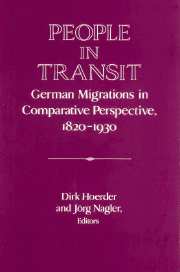Book contents
- Frontmatter
- Introduction
- PART I CONTINUITY AND COMPLEXITY: MIGRATIONS FROM EAST ELBIAN GERMANY AND GALICIAN POLAND
- Part II Internal German Migrations and In-Migrations
- PART III WOMEN'S MIGRATION: LABOR AND MARRIAGE MARKETS
- PART IV ACCULTURATION IN AND RETURN FROM THE UNITED STATES
- 14 Communicating the Old and the New: German Immigrant Women and Their Press in Comparative Perspective around 1900
- 15 Return Migration to an Urban Center: The Example of Bremen, 1850-1914
- 16 Migration, Ethnicity, and Working-Class Formation: Passaic, New Jersey, 1889-1926
- 17 Changing Gender Roles and Emigration: The Example of German Jewish Women and Their Emigration to the United States, 1933-1945
- 18 Migration Past and Present - The German Experience
- 19 Research on the German Migrations, 1820s to 1930s: A Report on the State of German Scholarship
- Index
16 - Migration, Ethnicity, and Working-Class Formation: Passaic, New Jersey, 1889-1926
Published online by Cambridge University Press: 05 January 2013
- Frontmatter
- Introduction
- PART I CONTINUITY AND COMPLEXITY: MIGRATIONS FROM EAST ELBIAN GERMANY AND GALICIAN POLAND
- Part II Internal German Migrations and In-Migrations
- PART III WOMEN'S MIGRATION: LABOR AND MARRIAGE MARKETS
- PART IV ACCULTURATION IN AND RETURN FROM THE UNITED STATES
- 14 Communicating the Old and the New: German Immigrant Women and Their Press in Comparative Perspective around 1900
- 15 Return Migration to an Urban Center: The Example of Bremen, 1850-1914
- 16 Migration, Ethnicity, and Working-Class Formation: Passaic, New Jersey, 1889-1926
- 17 Changing Gender Roles and Emigration: The Example of German Jewish Women and Their Emigration to the United States, 1933-1945
- 18 Migration Past and Present - The German Experience
- 19 Research on the German Migrations, 1820s to 1930s: A Report on the State of German Scholarship
- Index
Summary
In the spring of 1919 thousands of textile workers in a small New Jersey town went on strike, demanding the eight-hour day. It was not their first walkout. What was unprecedented, however, was the participation of skilled workers. During the previous thirty years, these workers had sided with the millowners during industrial conflicts and had refused to join the action of their less skilled colleagues. In a radical shift in policy, the employers had now laid them off, leaving them with few alternatives but to join the struggle. The workers went to the union and asked “if they could join.” After stressing “that they have to come to us now,” the union accepted the new members.
Divisions between skilled and less skilled workers are not uncommon, but in Passaic, New Jersey, they acquired a particular twist. The worsted mills were owned by German entrepreneurs who had hired most of their skilled work force directly from Germany, while staffing the unskilled positions largely with eastern and southern European immigrants. This essay demonstrates how an alliance between German immigrant capital and German immigrant workers was successfully fostered through the preferential treatment of skilled workers and through the support of the German employees' religious, educational, and cultural institutions by the millowners. It analyzes the relationship between the social organization of migration, the making of ethnicity, and working-class formation and also attempts to understand the German immigrants' experience in relation to other migrant groups as well as the internal structure of the immigrant community itself.
- Type
- Chapter
- Information
- People in TransitGerman Migrations in Comparative Perspective, 1820–1930, pp. 347 - 378Publisher: Cambridge University PressPrint publication year: 1995
- 1
- Cited by

